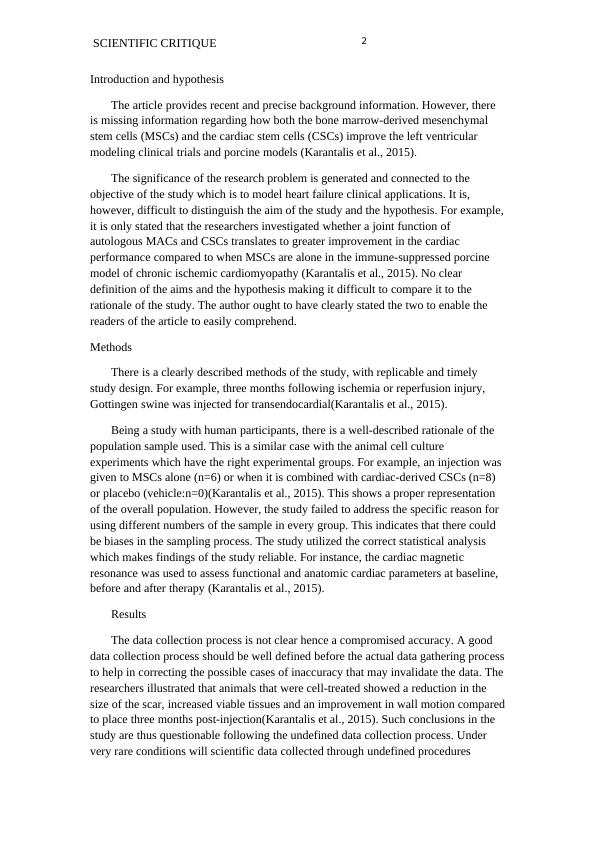Scientific Critique of Synergistic Effects of Combined Cell Article 2022
Added on 2022-09-22
4 Pages899 Words21 Views
1Running Head: SCIENTIFIC CRITIQUE
Scientific Critique of Synergistic Effects of Combined Cell
Therapy for Chronic Ischemic Cardiomyopathy
Name
Institutional Affiliation
Date
Scientific Critique of Synergistic Effects of Combined Cell
Therapy for Chronic Ischemic Cardiomyopathy
Name
Institutional Affiliation
Date

2SCIENTIFIC CRITIQUE
Introduction and hypothesis
The article provides recent and precise background information. However, there
is missing information regarding how both the bone marrow-derived mesenchymal
stem cells (MSCs) and the cardiac stem cells (CSCs) improve the left ventricular
modeling clinical trials and porcine models (Karantalis et al., 2015).
The significance of the research problem is generated and connected to the
objective of the study which is to model heart failure clinical applications. It is,
however, difficult to distinguish the aim of the study and the hypothesis. For example,
it is only stated that the researchers investigated whether a joint function of
autologous MACs and CSCs translates to greater improvement in the cardiac
performance compared to when MSCs are alone in the immune-suppressed porcine
model of chronic ischemic cardiomyopathy (Karantalis et al., 2015). No clear
definition of the aims and the hypothesis making it difficult to compare it to the
rationale of the study. The author ought to have clearly stated the two to enable the
readers of the article to easily comprehend.
Methods
There is a clearly described methods of the study, with replicable and timely
study design. For example, three months following ischemia or reperfusion injury,
Gottingen swine was injected for transendocardial(Karantalis et al., 2015).
Being a study with human participants, there is a well-described rationale of the
population sample used. This is a similar case with the animal cell culture
experiments which have the right experimental groups. For example, an injection was
given to MSCs alone (n=6) or when it is combined with cardiac-derived CSCs (n=8)
or placebo (vehicle:n=0)(Karantalis et al., 2015). This shows a proper representation
of the overall population. However, the study failed to address the specific reason for
using different numbers of the sample in every group. This indicates that there could
be biases in the sampling process. The study utilized the correct statistical analysis
which makes findings of the study reliable. For instance, the cardiac magnetic
resonance was used to assess functional and anatomic cardiac parameters at baseline,
before and after therapy (Karantalis et al., 2015).
Results
The data collection process is not clear hence a compromised accuracy. A good
data collection process should be well defined before the actual data gathering process
to help in correcting the possible cases of inaccuracy that may invalidate the data. The
researchers illustrated that animals that were cell-treated showed a reduction in the
size of the scar, increased viable tissues and an improvement in wall motion compared
to place three months post-injection(Karantalis et al., 2015). Such conclusions in the
study are thus questionable following the undefined data collection process. Under
very rare conditions will scientific data collected through undefined procedures
Introduction and hypothesis
The article provides recent and precise background information. However, there
is missing information regarding how both the bone marrow-derived mesenchymal
stem cells (MSCs) and the cardiac stem cells (CSCs) improve the left ventricular
modeling clinical trials and porcine models (Karantalis et al., 2015).
The significance of the research problem is generated and connected to the
objective of the study which is to model heart failure clinical applications. It is,
however, difficult to distinguish the aim of the study and the hypothesis. For example,
it is only stated that the researchers investigated whether a joint function of
autologous MACs and CSCs translates to greater improvement in the cardiac
performance compared to when MSCs are alone in the immune-suppressed porcine
model of chronic ischemic cardiomyopathy (Karantalis et al., 2015). No clear
definition of the aims and the hypothesis making it difficult to compare it to the
rationale of the study. The author ought to have clearly stated the two to enable the
readers of the article to easily comprehend.
Methods
There is a clearly described methods of the study, with replicable and timely
study design. For example, three months following ischemia or reperfusion injury,
Gottingen swine was injected for transendocardial(Karantalis et al., 2015).
Being a study with human participants, there is a well-described rationale of the
population sample used. This is a similar case with the animal cell culture
experiments which have the right experimental groups. For example, an injection was
given to MSCs alone (n=6) or when it is combined with cardiac-derived CSCs (n=8)
or placebo (vehicle:n=0)(Karantalis et al., 2015). This shows a proper representation
of the overall population. However, the study failed to address the specific reason for
using different numbers of the sample in every group. This indicates that there could
be biases in the sampling process. The study utilized the correct statistical analysis
which makes findings of the study reliable. For instance, the cardiac magnetic
resonance was used to assess functional and anatomic cardiac parameters at baseline,
before and after therapy (Karantalis et al., 2015).
Results
The data collection process is not clear hence a compromised accuracy. A good
data collection process should be well defined before the actual data gathering process
to help in correcting the possible cases of inaccuracy that may invalidate the data. The
researchers illustrated that animals that were cell-treated showed a reduction in the
size of the scar, increased viable tissues and an improvement in wall motion compared
to place three months post-injection(Karantalis et al., 2015). Such conclusions in the
study are thus questionable following the undefined data collection process. Under
very rare conditions will scientific data collected through undefined procedures

End of preview
Want to access all the pages? Upload your documents or become a member.
Related Documents
Cardiovascular Health: Genes and Hormones Assignment 2019 Theme Blg...
|5
|1631
|19
Evaluation of Quality of Life in Laryngeal Cancer Patients After Total Laryngectomylg...
|10
|3384
|33
